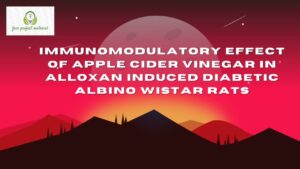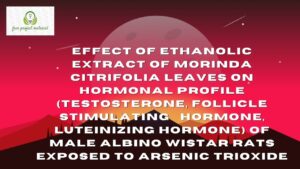ABSTRACT
The aim of this study was to determine the proximate composition of Tapinanthus bangwnesis leaves. Standard analytical methods were used to analyzed the samples. The results of the study revealed the following; moisture content, (20.56±0.085%), ash (6.09±0.20%), crude fibre (44.68±0.106%), crude protein (0.63±0.099%), crude fat (15.36±0.148%), carbohydrate (33.51±0.099%) and caloric value (273.32±0.092 Kcal). The results indicate that the leaves of Tapinanthis bangwensis is rich in ash and crude fibre contents and as such suitable for consumption by patients who need high fibre contents in foods. The high ash contents suggest a good potential source of minerals elements. It is then recommended that its consumption be considered and the antinutritional composition of the leaves sample be analyzed in order to ascertain it safety for consumption by humans.
TABLE OF CONTENTS
TITLE PAGE – – – – – – – – i
CERTIFICATION – – – – – – – – ii
DEDICATION – – – – – – – – iii
ACKNOWLEDGEMENT – – – – – – iv
ABSTRACT – – – – – – – – v
TABLE OF CONTENTS – – – – – – vi-viii
CHAPTER ONE: INTRODUCTION
1.1 Background of the Study – – – – – – 1
1.2 Aim and Objectives of the Study – – – – 3
CHAPTER TWO: LITERATURE REVIEW
2.1 Description of Tapinanthus bangwensis Plant – – 5
2.2 Botanical Classification of bangwensis Plant – – – 6
2.3 Phytochemical Property of bangwensis Plant – – 7
2.4 Medicinal Uses of bangwensis Plant – – – 7
2.5 Proximate Composition of bangwensis Plant – – 10
2.5.1 Moisture Content – – – – – – – 10
2.5.2 Ash Content – – – – – – – – 15
2.5.3 Crude Fiber – – – – – – – – 17
2.5.4 Crude Fat – – – – – – – – 18
2.5.5 Protein – – – – – – – – 20
2.5.6 Caloric Value – – – – – – – 24
2.5.7 Carbohydrate – – – – – – – 25
CHAPTER THREE: MATERIALS AND METHODS
3.1 Materials and Reagents – – – – – – 27
3.1.1 Sample Collection and Preparation – – – – – 27
3.2 Methods – – – – – – – – 28
3.2.1 Determination of Moisture Content – – – – 28
3.2.2 Determination of Ash Content – – – – – 28
3.2.3 Determination of Crude Fiber – – – – – 29
3.2.4 Determination of Protein – – – – – – 30
3.2.5 Determination of crude fat – – – – – 32
3.2.6 Determination of Crude Carbohydrate – – – – 33
3.2.7 Determination of Caloric Value – – – – – 34
CHAPTER FOUR: RESULTS AND DISCUSSION
4.1 Results – – – – – – – – 35
4.2 Discussion – – – – – – – – 36
CHAPTER FIVE: CONCLUSION AND RECOMMENDATIONS
5.1 Conclusion – – – – – – – – 45
5.2 Recommendations – – – – – – – 45
References
CHAPTER ONE: INTRODUCTION
1.1 Background of the Study
In recent years, there has been a gradual revival of interest in the use of medicinal plants in developing countries because herbal medicines have been reported to be safe with little or no adverse side effects especially when compared to synthetic drugs. Thus, a search for new drugs with better and cheaper constituents from plant origin is a natural choice. The medicinal value of these plants lie in some chemical substances that produce a definite physiological action on the human body (Edeoga et al., 2005).
Plants have played significant roles in maintaining the health and quality of human life for thousands of years. The majority of the earth’s inhabitants in the developing world rely on traditional medicine for their primary health care needs and a major part of this therapy involves the use of plants, plants extracts, or their active principles (Craig, 2001). Herbaceous plants produce and contain a variety of chemical substances that act upon the body (Shayoub, 2003). Medicinal plants and herbs are of great importance to the health of individuals and communities. Despite the existence of herbal medicines over many centuries, only relatively small number of plant species has been studies for their application (Omoruyi and Onyeneke, 2011). However, in the recent past, an increasing research evidence is getting accumulated which clearly indicate the positive role of traditional medicinal plant in the prevention or control of some metabolic disorders like diabetes, heart diseases and certain types of cancer (Zang, 1996). A scientific investigation of traditional herbal remedies for metabolic disorders may provide valuable lead for the development of alternative drug and therapeutic strategies.
Mistletoe is the common name for a group of hemiparasitic plants in the order Santatales that grow attached to and within the branches of a tree or shrub. The leaves of mistletoe (Tapinanthus bangwensis) have been used traditionally in Nigeria and other parts of Africa as antihypertensive and antidiabetic agents. Various researchers have reported the hypotensive, hypoglycemic and hypolipidemic which lowers the blood pressure, blood glucose and lipid profile. Tapinanthus bangwensis (Loranthaceae) is a parasitic woody shrub with a pendulous stem of up to 2m long. It is found in the forest region from Senegal to Cameroon and extends over the Congo basin to Zaire. Traditionally, the leaves are used in Ghana to treat guinea worms while in Nigeria, they are used to treat various ailments such as cancer and liver disorder (Burkill, 1995). The plant is used with Gardenia tricantha (Rubiaceae) for the treatment of leprosy in Senegal (Burkill, 1995). Flavonoids, lectins, polypeptides, triterpenes, and polyphenoloic compounds have been reported in the plant (Duong et al., 2003). The presence of phlobotannins, alkaloids, anthraquinones as well as cardiac and steroidal glycosides have also been reported (Wahab et al., 2010).
1.2 Aim And Objectives of the Study
Aim of the Study
The aim of this study is to determine the proximate composition of Tapinanthus bangwensis leaf.
Objectives of the Study
The objectives of this study include the following;
- To determine the moisture content of Tapinanthus bangwensis leaf
- To determine the ash content of Tapinanthus bangwensis leaf
- To determine the crude fiber contents of Tapinanthus bangwensis leaf
- To determine the protein contents of Tapinanthus bangwensis leaf
- To determine the crude fat contents of Tapinanthus bangwensis leaf
- To determine the caloric value of Tapinanthus bangwensis leaf\



